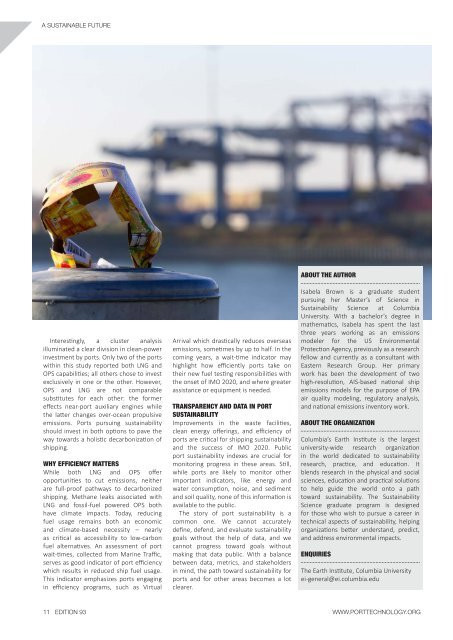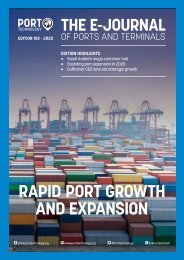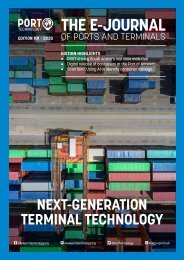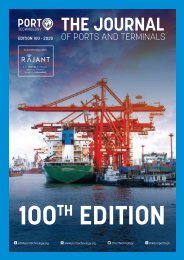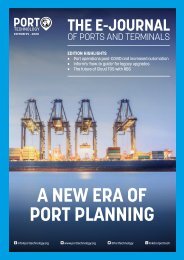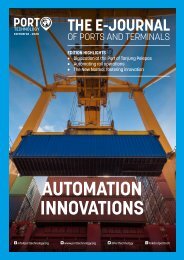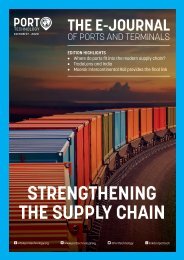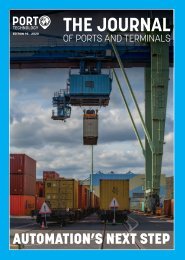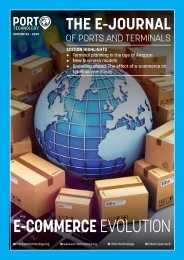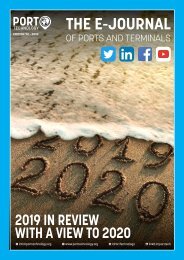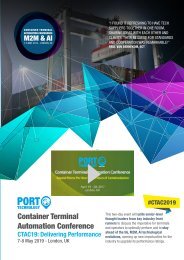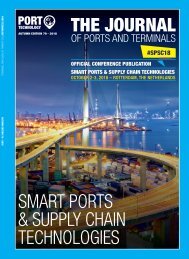A Sustainable Future
Port Technology International’s first e-Journal of 2020 explores the topic of sustainability in ports. Climate change is set to be a defining topic for the 2020s as awareness of its real-time impact is increasing.
Port Technology International’s first e-Journal of 2020 explores the topic of sustainability in ports. Climate change is set to be a defining topic for the 2020s as awareness of its real-time impact is increasing.
You also want an ePaper? Increase the reach of your titles
YUMPU automatically turns print PDFs into web optimized ePapers that Google loves.
A SUSTAINABLE FUTURE<br />
Interestingly, a cluster analysis<br />
illuminated a clear division in clean-power<br />
investment by ports. Only two of the ports<br />
within this study reported both LNG and<br />
OPS capabilities; all others chose to invest<br />
exclusively in one or the other. However,<br />
OPS and LNG are not comparable<br />
substitutes for each other: the former<br />
effects near-port auxiliary engines while<br />
the latter changes over-ocean propulsive<br />
emissions. Ports pursuing sustainability<br />
should invest in both options to pave the<br />
way towards a holistic decarbonization of<br />
shipping.<br />
WHY EFFICIENCY MATTERS<br />
While both LNG and OPS offer<br />
opportunities to cut emissions, neither<br />
are full-proof pathways to decarbonized<br />
shipping. Methane leaks associated with<br />
LNG and fossil-fuel powered OPS both<br />
have climate impacts. Today, reducing<br />
fuel usage remains both an economic<br />
and climate-based necessity – nearly<br />
as critical as accessibility to low-carbon<br />
fuel alternatives. An assessment of port<br />
wait-times, collected from Marine Traffic,<br />
serves as good indicator of port efficiency<br />
which results in reduced ship fuel usage.<br />
This indicator emphasizes ports engaging<br />
in efficiency programs, such as Virtual<br />
Arrival which drastically reduces overseas<br />
emissions, sometimes by up to half. In the<br />
coming years, a wait-time indicator may<br />
highlight how efficiently ports take on<br />
their new fuel testing responsibilities with<br />
the onset of IMO 2020, and where greater<br />
assistance or equipment is needed.<br />
TRANSPARENCY AND DATA IN PORT<br />
SUSTAINABILITY<br />
Improvements in the waste facilities,<br />
clean energy offerings, and efficiency of<br />
ports are critical for shipping sustainability<br />
and the success of IMO 2020. Public<br />
port sustainability indexes are crucial for<br />
monitoring progress in these areas. Still,<br />
while ports are likely to monitor other<br />
important indicators, like energy and<br />
water consumption, noise, and sediment<br />
and soil quality, none of this information is<br />
available to the public.<br />
The story of port sustainability is a<br />
common one. We cannot accurately<br />
define, defend, and evaluate sustainability<br />
goals without the help of data, and we<br />
cannot progress toward goals without<br />
making that data public. With a balance<br />
between data, metrics, and stakeholders<br />
in mind, the path toward sustainability for<br />
ports and for other areas becomes a lot<br />
clearer.<br />
ABOUT THE AUTHOR<br />
Isabela Brown is a graduate student<br />
pursuing her Master’s of Science in<br />
S ustainability S cience at Columbia<br />
U niversity. With a bachelor’ s degree in<br />
mathematics, Isabela has spent the last<br />
three years working as an emissions<br />
modeler for the US Environmental<br />
Protection Agency, previously as a research<br />
fellow and currently as a consultant with<br />
Eastern Research Group. Her primary<br />
work has been the development of two<br />
high-resolution, AIS-based national ship<br />
emissions models for the purpose of EPA<br />
air quality modeling, regulatory analysis,<br />
and national emissions inventory work.<br />
ABOUT THE ORGANIZATION<br />
Columbia’s Earth Institute is the largest<br />
university-wide research organization<br />
in the world dedicated to sustainability<br />
research, practice, and education. It<br />
blends research in the physical and social<br />
sciences, education and practical solutions<br />
to help guide the world onto a path<br />
toward sustainability. The S ustainability<br />
S cience graduate program is designed<br />
for those who wish to pursue a career in<br />
technical aspects of sustainability, helping<br />
organizations better understand, predict,<br />
and address environmental impacts.<br />
ENQUIRIES<br />
The Earth Institute, Columbia University<br />
ei-general@ ei.columbia.edu<br />
11 EDITION 93<br />
WWW.PORTTECHNOLOGY.ORG


